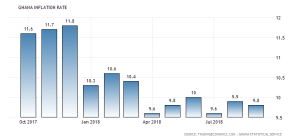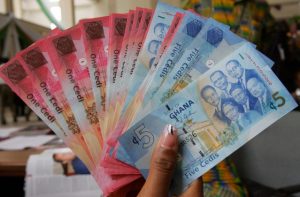“Ghana’s central bank has maintained the benchmark policy rate at 17.0% in line with our expectations. The decision was driven by short-term inflationary pressures from GHS depreciations in the last three months.” – Doobia
See the central bank’s release below.
1. Ladies and Gentlemen of the Press, we welcome you to this morning’s press conference of the 83rd meeting of the Monetary Policy Committee (MPC). The Committee undertook a review of recent economic developments and we present the highlights of the discussions that informed the decision on the stance of monetary policy.
2. Global growth continues to remain strong even though the expansion is uneven and risks to the medium-term outlook are mounting. While the rebound in the United States continues, activity in the Euro area, Japan and the United Kingdom has been sluggish. Policy uncertainty and a potential trade war could change the outlook significantly. In emerging market and developing economies, growth conditions are improving although downside risks remain, stemming from rising crude oil prices, tightening financing conditions and escalating trade tensions.
3. Global inflation has picked up in most advanced economies driven mainly by wage dynamics as labour market conditions tighten and crude oil price increases. Core inflation, however, remains benign but may pick up. Inflation pressures in emerging market economies, on the other hand, are gradually moderating.
4. The Ghanaian economy continues to record strong growth with a 6.8 percent GDP growth in the first quarter of 2018, compared with 6.7 percent in the same period of 2017. Non-oil growth for the first quarter also picked up strongly to 5.4 percent, from 4.0 percent in the comparative period of 2017. The growth pickup is evidenced in a stronger rebound by the services sector, which rose by 5.2 percent, compared with 3.4 percent in the same period of 2017. The Bank’s Composite Index of Economic Activity (CIEA) also showed a strong pickup reflecting increased industrial consumption of electricity, cement sales and exports. The real CIEA recorded an annual growth of 3.2 percent in May 2018, compared to 2.6 percent in the corresponding period of 2017.
5. Businesses and consumers were positive on growth and employment prospects, despite concerns about exchange rate movements. However, the business and consumer confidence surveys indicate moderation in overall sentiments. 6. Growth in key monetary aggregates slowed down significantly from a year ago, consistent with the disinflation process and the on-going cleaning up in the financial sector. Annual growth in broad money supply (including foreign currency deposits) eased to 13.0 percent in June 2018, from 28.9 percent in June 2017 reflecting a 13.4 percent annual decline in Net Foreign Assets.
7. Government budgetary operations for the period January to May 2018, indicated that revenue and grants amounted to GH¢17.4 billion (7.2% of GDP) and 7.6 percent less than programmed. Total expenditures, including arrears clearance, was GH¢22.6 billion (9.4% of GDP) and 6.4 percent short of the target. These developments resulted in an overall cash deficit of 2.6 percent of GDP, higher than the targeted 2.4 percent of GDP for the review period.
8. Total public debt declined from 67.3 percent of GDP (GH¢137.3 billion) in May 2017 to 63.8 percent of GDP (GH¢154.3 billion) at the end of May 2018. Of the total debt stock, domestic debt was GH¢72.6 billion accounting for 47.0 percent and external debt was GH¢81.7 billion with a share of 53.0 percent. On the international commodities markets, crude oil prices rose by 18.2 percent on year-to-date basis to an average of US$75.
9 per barrel in June 2018 due to supply constraints amidst geopolitical tensions. Crude oil prices have retreated somewhat in recent weeks as OPEC agreed to boost production. Gold prices gained a marginal 1.1 percent on year-to-date basis to US$1,281.1 per fine ounce. Cocoa prices continue to recover due to cut back in global production forecasts and increased demand, with prices increasing to US$2,435.7 per tonne in June 2018, representing a year-to-date growth of 27.9 percent.
10. These price developments, together with improved production outturns, especially in crude oil, translated into a positive trade balance. Provisional estimates indicated that the trade account recorded a surplus of US$1.1 billion (2.1% of GDP) at the end of June 2018, reflecting higher export receipts from crude oil. This compares with a surplus of US$1.1 billion (2.4% of GDP) recorded over the same period in 2017. Provisional data show that the current account recorded a deficit of US$334 million (0.6% of GDP) at the end of June 2018 compared to a deficit of US$181 million (0.4% of GDP) for the same period of 2017.
11. Over the past two months, normalisation of US monetary policy resulting in strengthening of the US dollar and rising US yield rates have continued to weigh-in on emerging market assets. A combination of these factors led to tight financing conditions and reverse capital flows in a number of emerging market and frontier economies, including Ghana.
12. These external factors, together with increased demand for foreign exchange from the corporate and energy related sectors, exerted pressure on the domestic currency market. Consequently, the Cedi, which had performed strongly against the major international currencies over the first four months of the year, depreciated in May and June. In the year to July 19th, the Cedi has cumulatively depreciated by 5.8 percent against the US dollar, compared to 3.9 percent observed during the same period of last year. Despite the sharp depreciation observed, the real effective exchange rate (in trade-weighted terms) remained broadly aligned with underlying fundamentals.
13. The Gross International Reserves (GIR) at the end of June 2018 was US$7.3 billion, equivalent to 3.9 months of import cover, providing enough buffer against the aforementioned external shocks and remains adequate to enable the Bank address any external vulnerabilities.
14. Headline inflation edged up from 9.6 percent in April to 9.8 in May and further to 10.0 percent in June. These upward movements were mainly driven by the recent increase in administered transport fares.
15. Notwithstanding these developments, underlying inflation pressures remain subdued. The core measure of inflation which excludes volatile food items and transportation costs came down. The weighted inflation expectations of businesses, consumers and the financial sector over the next six months declined and remained well-anchored.
16. Money market interest rates continue to trend downwards. Interest rates on the 91-day Treasury bill declined further to 13.3 percent in June 2018, from 16.9 percent a year ago. Similarly, the 182-day instrument declined to 13.9 percent from 17.1 percent, while the 1-year note also dropped to 15.0 percent from 19.0 percent over the same comparative period. The weighted average interbank rate, the rate at which commercial banks lend to each other, declined further to 16.4 percent in June 2018 from 24.9 percent a year ago. The Ghana Reference Rate declined from 16.74 percent in May 2018 to 16.19 percent as at June.
17. Reconstruction and balance sheet repairs in the financial sector are on-going and there are emerging signs of some turnaround as banks prepare to meet the new minimum capital requirement. Latest developments in banks’ balance sheet showed an increase in total assets to GH¢100.3 billion in June 2018, indicating an annual growth of 15.7 percent. The asset growth was mainly funded by deposits which went up by 13.4 percent on a year-on-year basis. The industry’s average Capital Adequacy Ratio (CAR) improved to 19.3 percent in June 2018 from 18.2 percent in April 2018, reflecting efforts by banks to recapitalize. So far, six banks have met the new minimum capital requirement, two others are almost within range of compliance, while the rest are at different stages of compliance in accordance with their submitted capital requirement plans.
18. Credit to the private sector at the end of June 2018 grew by 5.7 percent compared with 2.4 percent at the end of March. This trend however, fell short of the 15.1 percent recorded a year earlier. Banks and Specialised Deposit-Taking Institutions (SDIs) are however increasing disbursement of new loans. New advances in the banking and SDIs sectors continued to increase in the year, recording a 24.7 percent year-to-date growth in June 2018, compared with 4.2 percent growth in the same period of last year.
19. Overall, the financial soundness indicators of the banking industry have improved moderately since the last MPC meeting, although pockets of weaknesses remain. The Non-Performing Loans (NPLs) ratio eased slightly to 22.6 percent in June 2018 from 23.4 percent in April. Adjusting for loan loss provisioning, the NPLs ratio remained stable at 12.3 percent.
Summary and Outlook
20. To summarise, global conditions are characterised by geopolitical tensions and uncertainties in the external environment. These have been heightened by fears of trade protectionism resulting from rising trade tensions between the US and China, and uncertainties in the crude oil market. These developments could impact global growth outlook. There are also concerns about further tightening of US monetary policy with adverse implications on capital flows and currency markets for emerging market and frontier economies.
21. The Committee noted that overall growth in the Ghanaian economy is projected to remain high, although private sector credit growth remains below expectations. There are however emerging signs of recovery evidenced by increased new loan advances and easing credit stance on loans to households despite the on-going repair of banks’ balance sheets. These, together with positive sentiments by both consumers and businesses, should help spur growth over the medium term.
22. The mid-year review of the 2018 budget signaled strong commitment to fiscal consolidation as the end-year fiscal deficit target of 4.5 percent was maintained. In response to the shortfall in revenues during the first half of the year, government has introduced new measures to close revenue gaps in the budget alongside expenditure cutbacks. However, this will require vigilance to help keep the fiscal consolidation process on track to sustain the gains in macroeconomic stability.
23. Headline and core inflation have trended up in recent months although inflation expectations remain broadly well-anchored. The medium-term forecast has remained broadly unchanged and suggests a gradual return to the central path over the horizon.
24. In assessing the balance of risks, the Committee was of the view that although inflation had moved upwards in the recent readings, this came mainly from the effects of increases in administered prices of petroleum and transportation costs. The Committee viewed that second round effects from these relative price changes would not be significant enough to alter the inflation trajectory over the medium-term. This would require continued fiscal consolidation together with tight monetary policy to keep inflation within the target band.
25. Given the circumstances, especially with regards to the global outlook, the Committee decided to maintain the Monetary Policy Rate at 17.0 percent while closely monitoring developments in the near-term. The Committee stands ready to take the appropriate policy measures to promptly address any potential threats to the disinflation path.




